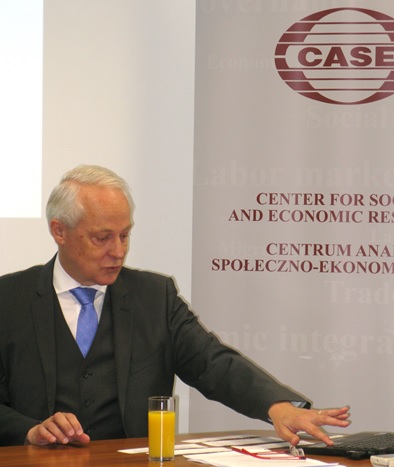Can public policies stimulate the demand for innovation in businesses?
Each year in Europe 19% of public spending, that is over 2.300bn euros, goes to the public procurement but only a tiny share of this is allocate to innovative projects. However, if these activities are to be effective, policies should focus more on the interplay between public organizations and private business - said Peter Lindholm during seminar “Can public policies stimulate the demand for innovation in businesses?”. The event, which took place on 30th of June 2014 in CASE’s office, was organized within PICK-ME project financed by the European Union’s FP7 programme.
Over years innovation policies have merely focused on implementing an innovation infrastructure that could supply services to firms willing to innovate. This includes physical infrastructures (technoparks, incubators, engineering centres, etc.) and soft infrastructure (financial support, business advisory services, etc.). The concept of stimulating the demand side for innovation was not actively pursued and little evidence were collected to determine which measures could work best in different business environments.
 As Peter Lindholm stated, Public Procurement for Innovation (PPI), the focal point of the presentation, is of primary importance in the context of the so-called grand challenges (global warming, tightening supplies of energy, water and food, ageing societies, public health, pandemics, or security). It is a classical tool for supporting demand-driven innovation, highly popular since it is a direct one – the government does not have to stimulate demand, it simply generates it. On the whole, there are three main types of PPIs: Pre-Commercial Procurement (PCP), Adaptive PPI, and Developmental PPI. PCP refers to the procurement of (expected) research results and is a matter of direct public R&D investments (not the actual product development). The second one concerns situation when the product or system procured is incremental and new only to the country (or region) of procurement. Hence, innovation is required in order to adapt the product to specific national or local conditions. The last type relates to the completely new-to-the-world products and systems that are created as a result of the procurement process.
As Peter Lindholm stated, Public Procurement for Innovation (PPI), the focal point of the presentation, is of primary importance in the context of the so-called grand challenges (global warming, tightening supplies of energy, water and food, ageing societies, public health, pandemics, or security). It is a classical tool for supporting demand-driven innovation, highly popular since it is a direct one – the government does not have to stimulate demand, it simply generates it. On the whole, there are three main types of PPIs: Pre-Commercial Procurement (PCP), Adaptive PPI, and Developmental PPI. PCP refers to the procurement of (expected) research results and is a matter of direct public R&D investments (not the actual product development). The second one concerns situation when the product or system procured is incremental and new only to the country (or region) of procurement. Hence, innovation is required in order to adapt the product to specific national or local conditions. The last type relates to the completely new-to-the-world products and systems that are created as a result of the procurement process.
The idea of employing public procurement for the sake of innovation is not new. It has been widely used since the World War Two in the United States, Japan and China. Three important General Purpose Technologies (GPTs) – Internet, GPS Technology and Semi-Conductor Industry, are perhaps the most prominent examples resulting from government innovation-oriented interventions. Most often PPIs are not launched to stimulate the development of new products, but to target functions that satisfy human needs or solve societal problems. According to the presented data, public procurement represents currently more than 19% of all procurement activities, and amounts to over 2.3 trillion euros.
During the presentation, Peter. Lindholm presented and discussed solutions adopted in the United Kingdom, where all actions were based on the national strategy spelled out in the Innovation Nation White Paper. The document highlights the key role that public procurement plays in encouraging the development of new technologies and providing innovative, responsive to societal challenges solutions.
According to Peter. Lindholm, in the UK governmental departments are required to publish an innovation plan. In order to address societal challenges, all public institutions must ensure that public procurement is undertaken by professionals procurement officers able to take a broad perspective on cooperating with other public sector purchases and procurement bodies outside the department. As a result, departments need to be much more conscious and strategic in their operations and engagement in private sector.
During the debate that ensued after the seminar, members of the audience posed questions on many topics tackled during the presentation, among others: the crowding-out effect on private sector’s innovation funding, ways in which innovation research outsourcing may reduce the risks for the company, and the European Commission’s awareness regarding the actual costs of PPI. According to Peter Lindholm, there is no data available that would show that private procurement crowds out private investment in innovations.

